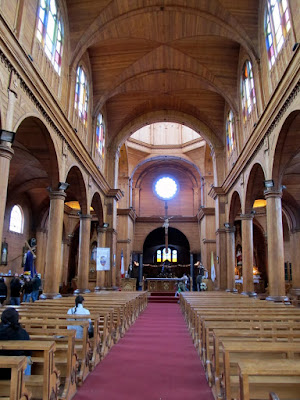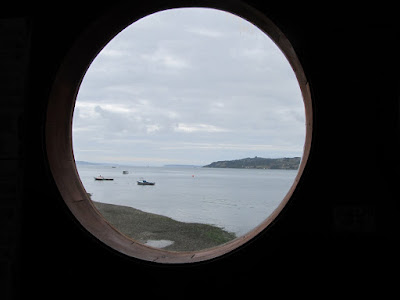The crossing from the mainland took about three hours - I was not seasick! We arrived in Quellon around six o' clock, from the distance it looked different!
It was difficult to find somewhere decent to sleep - but we didn't sleep here!
wandering round the harbour in the evening was refreshing, the views reminded us of Cornwall.
But the houses along the front were dilapidated.
We had a good look at the wood burning stoves for sale and
decided that Aga had based it designs on these.
The next day we were on the bus again to the capital of Chiloe Castro.
Chiloe is famous for its 1860's wooden churches built by the German Jesuits who came to live here after the Prussian wars. We had noticed the buildings along the Carretera Austral were very Bavarian and now we were sure that the Bavarians had settled in great numbers, houses had German proportions. The Churches beautifully constructed. Needless to say they had fallen into disrepair, but luckily in the last few years under the protection of UNESCO they have been made a World Heritage site.
A model exhibition of some of the churches was on display in the tourist information centre.
We explored the town, finding a very welcome cup of real coffee.
the climate in Chiloe is very variable - showers of rain come and go all day when we came out from enjoying coffee and a delicious sandwich the dogs were sheltering from the rain.
The largest wooden church in the world was reflected in the wet pavement.
Inside the church were some remarkable 16th century carvings all reflecting the agony of Christ.
The church itself was huge and quite beautiful.
One of the old oil lamps had been converted.
The Nativity was still in position, despite it being the middle of January.
The baby Jesus wrapped in modern swaddling clothes.
And St George was fighting the dragon.
Walking down to the port we saw the old town and its buildings.
We decided that they had been imported from the USA.
The boat was packed to the gunnels, even the straw was wedged in!
On Chiloe they grow elephant garlic!
In the port all sorts of sights met our eyes.
The work was all too much, and a siesta was needed!
The music was like a Barvarian dance - umm pa pa! But played by Chileans!
We found the craft market - there were the knitters!
and their products.
And for the soup dried mussels.
And then the bits for the tourists - if you like this sort of thing!
The next day we decided to take a tour out to one of the nearby islands.
We were to see several of the wooden churches, this one had been moved from one village to the next for 8 kms on rollers towed by oxen.
The museum displayed 15th century robes.

In front of a statue was a tray full of melted wax from burnt candles!.
We stopped for coffee.
In a boat shaped cafe.
It was a little alarming that they did not raise the gate at the end of the boat!
The tear shaped wooden cladding on the houses was designed so that the rain dripped downwards into the earth more easily. An idea brought from Germany.
Some remarkable statuary was evident, with some very clever lighting.
The carving was reminiscent of Bavaria - we thought.
The largest wooden church in the world was reflected in the wet pavement.
Inside the church were some remarkable 16th century carvings all reflecting the agony of Christ.
The church itself was huge and quite beautiful.
One of the old oil lamps had been converted.
The Nativity was still in position, despite it being the middle of January.
The baby Jesus wrapped in modern swaddling clothes.
And St George was fighting the dragon.
Walking down to the port we saw the old town and its buildings.
We were surprised to see some old trains.
We decided that they had been imported from the USA.
In the port several boats were loading up to return to their islands. This one would take 2 hours to get home. We asked the skipper if we could come but he didn't know when he was coming to the mainland again!
The boat was packed to the gunnels, even the straw was wedged in!
Finally the boat sailed away - just!
Someone was a little anxious about the weight.
Chiloe is famous for its shellfish and when you see the size of these mussels you can understand why!
We were very glad to see that the youngsters were still fishing.On Chiloe they grow elephant garlic!
In the port all sorts of sights met our eyes.
The work was all too much, and a siesta was needed!
The music was like a Barvarian dance - umm pa pa! But played by Chileans!
We found the craft market - there were the knitters!
and their products.
If you use seaweed in your cooking this might be just the thing!
Dried kelp too!And for the soup dried mussels.
And then the bits for the tourists - if you like this sort of thing!
Witches have names in Chiloe - El Trauco is one
And you can have your photo taken with one , if you like.The next day we decided to take a tour out to one of the nearby islands.
We were to see several of the wooden churches, this one had been moved from one village to the next for 8 kms on rollers towed by oxen.
This one was partially restored
with a very pretty font.The museum displayed 15th century robes.

In front of a statue was a tray full of melted wax from burnt candles!.
We stopped for coffee.
In a boat shaped cafe.
The bus was then put on the boat to go to the island
with this odd vehicle from Switzerland! It had been round the world!
The drive round the island offered splendid views.
A pre lunch stop was to sample oysters, Tony decided to have three small ones.
We remarked that we had never seen such large oysters and were surprised at the speed they girls opened them
Tony enjoyed his three!But then we went back to the stall - to see the biggest oysters we had ever seen.
One of our group ate 12 of these - and felt rather ill later in the day!The first settlers carved everthing from wood - this is a grinding wheel made of wood!
Lunch was not oysters, we stopped in a small town where the seaweed is collected for drying.
Houses were joined to each other.The tear shaped wooden cladding on the houses was designed so that the rain dripped downwards into the earth more easily. An idea brought from Germany.
Leaving the restaurant we went to see the next church.
Some remarkable statuary was evident, with some very clever lighting.
Jesus was always carrying his cross.
And Mary with Jesus as a small child.The carving was reminiscent of Bavaria - we thought.
Our final church was the biggest.
Inside it was huge.
From the bellfry the newly restored construction was a work of art.
The ceiling curved, painted and carved.
We wound our way back to the ferry passing more magnificent scenery, onto the ferry again and back to Castro. A wonderful day out in the country!














































































No comments:
Post a Comment